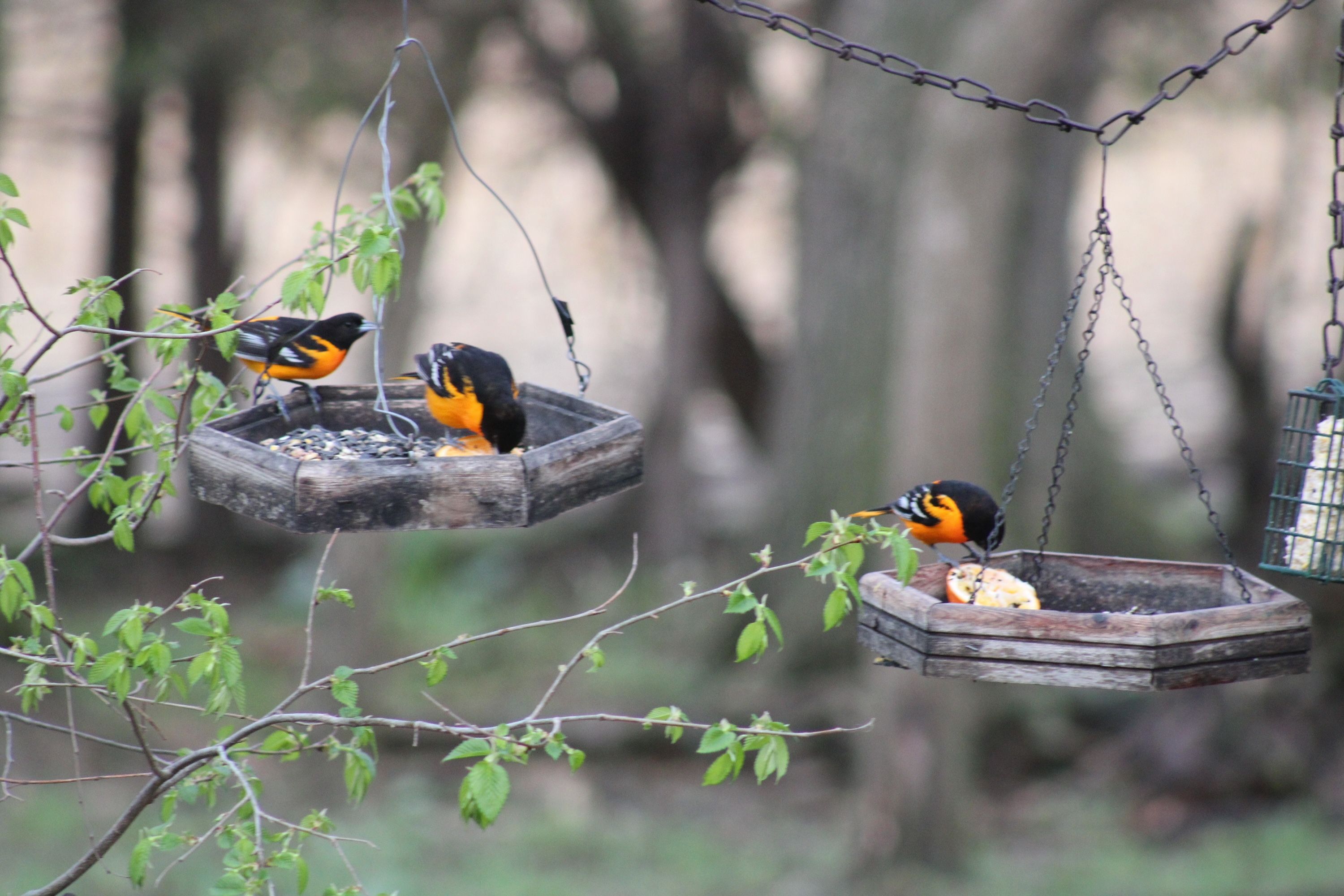
Photo of Baltimore orioles by Claire Wiltse.
Looking for ways to attract more birds to your yard? Bird feeders filled with a variety of seed are a good start, but don’t forget about bugs!
While many bird species eat mainly seeds, 95% of birds feed protein-rich bugs to their nestlings and fledglings. Incredibly, baby birds go from the size of an egg to nearly the size of an adult bird in a mere three weeks. They must eat large quantities of protein-rich insects to meet their nutritional needs, keeping their parents busy from dawn to dusk catching bugs to feed their growing offspring. Until the fledglings have learned to get their own food, you may notice a drop-off of visitors to your feeders.
Make your yard a bug buffet for birds by planting native! Native plants and trees are hosts for a wide variety of delectable insects, while non-natives are food-barren wastelands. An oak tree can support 534 insect species while the non-native Callery Pear, commonly known as a Bradford Pear, is an invasive tree from China and supports zero.
In addition to providing habitat for pollinators and other insects, native plants are drought resistant and can better survive our increasingly dry climate.
To keep your backyard busy with birds, delay clearing out your garden areas of leaves and dead foliage until planting season. Insects spend the winters under cozy ground cover, and become tasty treats for bug-eating birds.
What’s on the menu for some of our favorite bug-eaters?
Black-capped Chickadees: Chickadees forage mostly by hopping among twigs and branches, sometimes hanging upside down to reach the underside of branches. They are also known to catch insects while hovering and may catch insects in mid-air. They help control aphids, whiteflies, caterpillars, leafhoppers, earwigs, moths, and beetles.
Woodpeckers: Yards with lots of trees will find that Woodpeckers are frequent visitors, even if they do tend to nest in more heavily wooded areas. With more than 20 species in the U.S. alone, they make short work of moth larvae, beetles, borers, weevils, caterpillars, wasps, ants and millipedes. Woodpeckers’ chisel-like beaks are paired with unique cranial anatomy, letting them use their heads to hammer holes in trees without any ill effects.
Bluebirds: Bluebirds love insects and can spot insect prey over 60 feet away. Bluebirds can consume up to 2,000 insects in a single day (and they love mosquitoes). A brightly colored bird with a sweet song, the Bluebird is particularly effective at keeping grasshoppers under control. These prolific insect hunters also feed on a wide variety of additional insects, including crickets, beetles, larvae and moths; also spiders, earthworms and spider snails.
Nuthatches: Moving up and down the trees headfirst, Nuthatches search for insects, insect eggs, and cocoons hidden in tree bark and branches. They also forage for borers, caterpillars, ants, and earwigs. During the winter months, they seek out and forage on hibernating insects and their eggs.
Warblers: These small, colorful birds, known for their sweet songs, are extremely active insectivores, searching brushy areas, orchards, parklands, and forest edges for caterpillars, larvae, aphids, leafhoppers, whiteflies, and spiders.
Wrens: Wrens have a great appetite for insects, snails, and slugs. Minimizing insecticides and pesticides in the yard will ensure a healthy, abundant food source for Wrens. They will also pluck spiders from webs and glean ants, gnats, and other insects from foliage and tree bark.
Cardinals: In addition to being a backyard favorite, Cardinals live in a variety of habitats where they help farmers and gardeners by eating plant-harming pests including aphids, grasshoppers, slugs, snails, cotton cutworms, and bollworms. They also eat beetles, leafhoppers, cicadas, moths, and stink bugs.
More birds, more bugs
• Grosbeaks: larvae, caterpillars, beetles
• Orioles: caterpillars, larvae, beetles, grasshoppers
• Swallows: mosquitoes, moths, beetles, grasshoppers
• Titmice: aphids, leafhoppers, caterpillars, beetles

